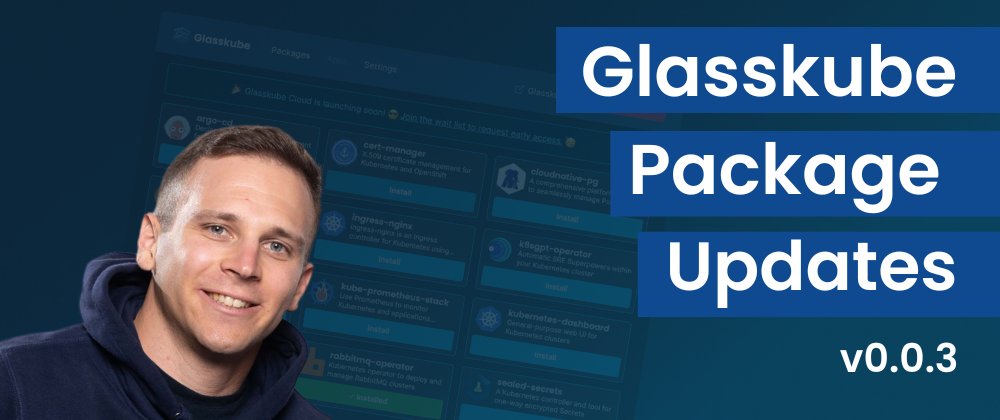Glasskube v0.0.3 — Introducing Package Updates

Glasskube v0.0.3 was released on February 27th, introducing package updates and many useful features for improved CLI and GUI experience.
Glasskube is fully open-source. Support us by leaving a star: ⭐ glasskube/glasskube ⭐
🙏 Special thanks to all our contributors 🥰
Once again, we can't thank our community enough for their valuable input and exciting contributions to Glasskube. We are happy you choose to be part of our journey in making Kubernetes package management easier for everyone.
This release includes:
- 👥 a total of 10 contributors
- 🛠️ 64 commits
- 💥 no breaking changes
Watch our release video to get an overview of what has changed:
Most notable changes
Package Updates
Updating packages is one of the most essential features of any package manager. That's why most of our efforts in the past two weeks
have gone into the support for such updates via CLI and GUI. It's as easy as typing glasskube update into the command line,
or a button click in the GUI.
During package installation you now can decide whether you want automatic updates for the package, in which case the
Glasskube package operator will take care of keeping you up to date at all times. You can of course opt out of this feature
if you prefer to handle updates manually. Apart from that, with the --version flag you can choose which version of a package is to be installed,
if your use case requires a specific version.
For technical details, please have a look at the package operator documentation.
Further improvements
We also worked hard on improving existing commands and our GUI. Here's a list of further notable changes:
- The
glasskube describecommand – and its GUI-complement, the package detail page – have been implemented for you to have a more detailed view on each of the packages available in Glasskube. glasskube listhas been extended with the new flags--outdated– listing only outdated packages, and--show-latest– showing the latest available version for each package.- All commands check for a newer version of Glasskube, and notify you if you are not up to date anymore.
- Glasskube is now even easier to set up: The GUI comes with handy pages for selecting a kubeconfig and for bootstrapping Glasskube in a cluster. All CLI commands will also support you in setting up Glasskube in your cluster.
- Streaming any kind of package status change directly into the GUI, making it easier for you to recognize when something is happening in the background.
BREAKING changes
This release does not contain any breaking changes.
All Release Notes
The release notes can be found here: v0.0.3 release on GitHub
All changes can be found here: Comparing v0.0.2 to v0.0.3
How to upgrade
Follow the installation instructions below to download the latest version of the Glasskube client. After that you need to upgrade the server component (Package Operator) by bootstrapping Glasskube again:
glasskube bootstrap
Getting started
Follow our Getting Started guide if you want to try Glasskube for yourself and install your first package.
- macOS
- Linux
- Windows
- NixOS/Nixpkgs
On macOS, you can use Homebrew to install and update Glasskube.
brew install glasskube/tap/glasskube
You can install Glasskube using one of the package managers below.RPM-based installation (RedHat/CentOS/Fedora)
dnf install https://releases.dl.glasskube.dev/glasskube_v0.26.1_amd64.rpmDEB-based installation (Ubuntu/Debian)
curl -LO https://releases.dl.glasskube.dev/glasskube_v0.26.1_amd64.deb
sudo dpkg -i glasskube_v0.26.1_amd64.debAPK-based installation (Alpine)
curl -LO https://releases.dl.glasskube.dev/glasskube_v0.26.1_amd64.apk
apk add --allow-untrusted glasskube_v0.26.1_amd64.apk
If you are using a distribution that does not use one of the package managers above, or require a 32-bit binary, check out additional download options attached to our latest release.
Download the windows archive from our latest Release and unpack it using Windows Explorer.
You can either use the package temporarily in a nix-shell:
nix-shell -p glasskube
Or install it globally by adding pkgs.glasskube to your environment.systemPackages.
After installing Glasskube on your local machine, make sure to install the necessary components in your Kubernetes cluster by running glasskube bootstrap.
For more information, check out our bootstrap guide.
Get involved
The easiest way to get involved is to tackle one of our open issues. You are also welcome to join our Discord.
If you are a cloud native developer, please submit your package.
As Glasskube is still in its very early days, your feedback is highly appreciated. Let us know what you think, we would love to hear from you or support us by leaving a star on GitHub: